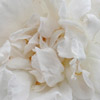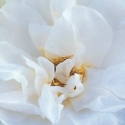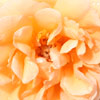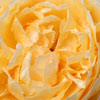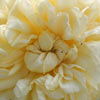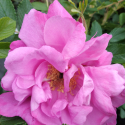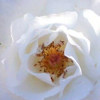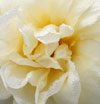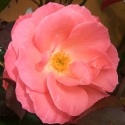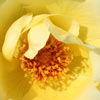Mail Order Rose Bushes New Zealand
At Wairere Nursery in the Waikato you will find the largest selection of mail order Roses in New Zealand. Climbing, Bush, Shrub, Austin, Hybrid Teas, Floribundas, Rambling, Patio, Heritage and Species roses are all stocked at Wairere. Roses of every colour from the crisp whites of 'Iceberg' and 'Pascali' to the sensuous reds of 'Dublin Bay' and 'Deep Secret' or maybe you would prefer the warm yellow blooms of 'Graham Thomas' or 'Friesia'. Looking pretty in pink are 'Compassion', 'The Fairy' and 'Abraham Derby' and there are enough scented roses to fill any garden with fragrance. Harry and Lloyd are willing and able to help with your selection and with their years of experience can offer you specialist knowledge on how to get the best from your roses. Wairere Nursery has been delivering roses to gardeners through-out New Zealand for more than 20 years and will carefully package and freight your selection direct to your door. Browse our secure web-site for rose shopping 24/7 or give us a call on 07-824-3430 for personal assistance. You are also most welcome to visit our nursery situated at 826 Gordonton Road, Hamilton which is open 7 days per week.
Alba roses all have the following characteristics:-
-White or pastel summer flowers that are delightfully fragrant
-Large grey-green foliage on slender stems
-Upright tall growth habit
-Very hardy with good disease resistance
-Low maintenance with only a light prune required after flowering
The most famous Alba rose is commonly known as "The White Rose of York", used as an emblem for the House of York during the War of the Roses (1455-1485). This rose is still grown and loved by modern gardeners today with the only battle being fought at the local Horticultural Society.
Born in 1926, on a farm in the English Midlands where he still resides, David started his breeding programme with the objective of combining "the best of the old with the best of the new". His first releases were crosses between Gallicas and Floribundas producing "Constance Spry" in 1961 and "Chianti" in 1967. Two lovely roses but only once flowering, the main aim was to produce reliable "repeaters". This was achieved in 1969 with the release of The Canterbury Tales series.
Around about the 1980's David Austin started to use the brand "English Roses" but such is our association with the man and his roses that these wonderful roses are simply and affectionately called "David Austin's" or just plain "Austin's".
International success was achieved in 1983 with the release of "Mary Rose" and "Graham Thomas". In 2009, 26 years after release, "Graham Thomas" was voted the "World's Favourite Rose" by the World Federation of Rose Societies. Many other awards followed for both the man and the roses. "Princess Alexandra of Kent" and "Munstead Wood" are two recent releases which have received top awards for fragrance.
David Austin has been awarded an OBE, the Victoria Medal of Honour by the Royal Horticultural Society, the Dean Hole Medal by the Royal National Rose Society, an Honorary MSc from the University of East London and a lifetime achievement award from the Garden Centre Association in 2004.
In the family owned rose nursery where David Austin now works along side his son, David junior, roughly 300,000 rose seeds are planted every year in order to find the next magical Austin to delight rose lovers around the world. Modern Austin roses have the desirable characteristics of good vigour and fragrance but to me their very best feature is that they are at their most beautiful when fully open. Simply irresistible!
Still, no matter who did what with whom and where they were when they did it, there is no doubt that French horticulturists were the first to recognize the potential of the Bourbon. They went on to reproduce an extremely popular group of roses which we still enjoy in our gardens today. Perhaps the most celebrated of these is Souvenir de la Malmaison - named after Empress Josephine's garden at Malmaison. The Empress, better known to gardeners as a great Rosarian rather than being the second Mrs Bonaparte continues to be a constant and important thread in our Rose story. Souvenir de la Malmaison is a rose that loves the warmth perhaps harking back to its origins in that little Island in the sun. Other desirables are La Reine Victoria, Mme Isaac Pereire, Mme Ernst Calvat and Commandant Beaurepaire (Vince's favourite Rose) - I know, that's a "treadful" joke!
The first descendant of Rosa chinensis to reach Europe is thought to be the hybrid "Old Blush" AKA "Parson's Pink" which was planted in Holland in 1781 and no doubt transported to England from there. 8 years later a red form was found growing in Calcutta and brought to England by Gilbert Slater of the British East India Company, this rose is known today as "Slater's Crimson China". These 2 humble roses are responsible for the remontancy in all the many and beautiful roses that we grow today. "Old Blush" is also an important forbear of Miniature Roses.
Climbing roses differ from Rambling roses in that they have more upright, thicker and stiffer stems or canes, with larger flowers which are produced throughout the season. Climbing roses are usually pruned in winter or early spring, along with shrub roses, whereas a "Rambler" is usually pruned immediately after flowering in summer.
It is important to establish a good framework for your Climbing rose in the first 2-3 years of growth. During this period you will have to do very little pruning except for any wayward shoots that apear outside your desired framework. Secure and train the upward canes in a fan shaped horizontal pattern. Lateral or side shoots will apear from these main canes and this is where your flowers will come from. These can be pruned back to about 1/3 of their growth in winter once your rose is established.
So step outside and look around. Is there a bare wall or a naked fence that would look so much better being dressed by a beautiful rose? Is there an area where a rose covered trellis would add some needed structure with a definite wow factor? With Climbing Roses no need to stay at ground level - rise above and let your imagination soar!
Climbing Patio roses will grow very hapily in a container; however this does mean that you will have to be committed to a regular watering and feeding regime to ensure a top performance. As you will be admiring the beautiful blooms as you go about your task it will hardly be arduous. Use to bring some softness to dull areas of the house or garden, ideal for training up a down-pipe or pillar.
Be sure to check out our page on Patio shrub roses as well.
If you wish to prune or tidy, this is best done after flowering in summer as Ramblers flower on what is called the "old wood" i.e. the previous season';;s growth. Only winter prune if severe treatment is needed, obviously this may compromise the flowering the following spring. No need to worry however as you will find it very hard to kill a modern rambling rose. So go outside and look up to where you would like to see pretty rather than ugly then scroll down and choose a robust rambler which will quickly provide the solution.
Do you enjoy wearing perfume or cologne? If so then give a thought to the ancient Damask Rose that is highly valued for its fragrance and subsequent production of Rose Oil or "Attar of Roses". Introduced to Europe by the returning Crusaders (no not the Canterbury Super 14 team) Damask roses quickly became popular and were widely used by Apothecaries of the day for "medicinal" purposes, with rose water being seen as a cure for almost every ill. I supose if you weren't cured at least you would smell better! Today hundreds of fields of Damask roses are still grown in Kazanlik, Bulgaria for the production of Attar of Roses. Can you imagine 3 tonnes of rose petals? That's what it takes to produce just 1kg of rose oil. The petals must be harvested between 5am and 10am as once the heat of the day commences then much of the valuable oil is lost. It must be a wonderful sight to see all the roses in full bloom just before harvesting. So when buying a Damask Rose you know that you are going to be rewarded with a deliciously fragrant rose. David Austin himself acknowledges the role of the Damask Rose in providing perfume for his modern day "English Roses." Other characteristics are subtle, soft grey/green foliage, very thorny shoots and summer flowers in varying shades of pink on short stalks. Many varieties will cope with poor soil and a little light shade. Add a little history to your planting scheme with these sensuous classic beauties.
As we leave the 1920’s behind and the birth of suburban life begins the modern Floribunda Rose starts to make an appearance. Compact and free flowering, this style of rose was just what modern gardeners were looking for. Initially these roses were known as Hybrid Polyanthas which we learnt last week means many flowered. The Americans, who were leaders in the development of this new style of rose, preferred the term Floribunda which they started to use in the 1930’s and this is the term still used by Rosarians today. Poulsen Roses of Denmark did some of the initial breeding of Floribundas producing a rose called Red Riding Hood which led to two more Floribundas called Else Poulsen and Kirsten Poulsen introduced in 1924. The American Nursery Jackson and Perkins continued the development and introduction of many new Floribundas and at one time this family owned nursery was renowned as the world’s largest rose grower. To name drop just a few famous Floribundas: - where would we be without[C1] Iceberg (and its many permutations), Margaret Merrill, Sexy Rexy or Satchmo? A personal favourite of mine is Queen Elizabeth not because I am an avid royalist but it was the first rose I learnt the name and history of when I was a budding pre-teen gardener. The main characteristic of Floribunda Roses is that their flowers are carried in large clusters or sprays giving a mass display often from spring right through to autumn.
Two of my very favourite "old" roses, "Anais Segales" and "Complicata" belong to the Gallica family and if they can be considered typical of the species then they are very easy to grow. R."Anais Segales" can be seen on many an old farm entrance way or fence line in NZ and can be recognized by its showy rich mauve blooms with the most exquisite petal formation.
If you don't notice the flowers immediately you will certainly smell the delicious perfume wafting through the air in early October as "Anais Segales" is one of the first roses to flower in spring. R. "Complicata" by way of contrast is a simple single rose of show-off pink and in full bloom it is a wonderful sight.
Gallica roses are another ancient species, and Rosa gallica Officinalis is better known as the Apothecary's Rose or Red Rose of Lancaster. Remember the War of the Roses between Lancaster and York? The White Rose of York is actually Rosa alba. The roses represented the warring factions of Lancaster and Yorkshire. Today peace is kept by R. damascena versicolor also known as R. York, and Lancaster which is a combination of blush pink and white.
Anyway back to Gallica roses which are characterized by neat rounded foliage with a serrated edge in a soft grey green tone. The plants are usually well contained at a height of no more than 1.5m. Warning: if grown from a cutting they will sucker and spread which is not necessarily a bad thing.
Most garden centre plants will be grafted and therefore not prone to spreading out of control. Many Gallicas have a strong fragrance but not all, so check out our individual descriptions. The flower colour ranges from deep pink to purple. Nice ornamental hips in autumn. The older wood has small bristly thorns but new growth is relatively thorn less.
One of the best features of the Gallica group is that they thrive in poor soil. So if you thought you didn't have the right conditions to grow good roses try a Gallica, we're sure you will be pleased with the results.
When you are shoping for roses, the Hybrid Musk rose will not be shouting out "Pick me, pick me" like its more flamboyant cousins. This does not mean that these quietly understated roses should be overlooked. For me they add a solid background of beauty to the rose garden or shrubbery.
The flowers tend to be simple and small; some are single but most are double. They have attractive prominent stamens and a soft musky perfume. The flowers apear in sprays or clusters on long branches and there are plenty of them. The excellent repeating characteristics of Hybrid Musk roses ensure that the blooms will continue from spring through to autumn even without regular dead heading. Small hips provide ongoing interest into winter.
The dark green foliage is usually glossy and healthy and there are relatively few thorns compared to many other varieties. Hybrid Musks are very hardy and will tolerate poorer soils without making too many demands for extra fuss and attention. Hybrid Musks are versatile and can be used as small climbers, background fillers or informal hedges. Look for some of our reliable favourites:- "Buff Beauty", "Ballerina", "Cornelia" and "Moonlight".
Hybrid Musks probably owe their personality to the man who was responsible for the development of this group of roses - Clergyman Joseph Pemberton from Essex, England. His parishioners were obviously very well behaved as Mr. Pemberton had the time to pursue his passion for rose breeding. He released his first rose on the market in 1913 and continued his breeding work until his death. What a fitting memorial that the modern gardener continues to admire and apreciate his efforts.
Characteristics of Hybrid Perpetual Roses
- Tall and Upright in Habit
- Large blooms that are often cupped and quartered
- Colour range white, pink, crimson, maroon and striped
- Fragrant
- Recurrent i.e. flower more than once a season
- Pruned after flowering
The birth of the ubiquitous Hybrid Tea rose occurred around the mid 1880’s and eventuated from some fairly random crosses between Hybrid Perpetual and Tea Roses. The resulting off-spring were not called Hybrid Teas but classified according to the dominant pollen parent. It wasn’t until 1884 that Hybrid Tea Roses were listed (in a catalogue put out by Dickson’s of Northern Ireland) as a distinct group. Many years later in 1898 the National Rose Society finally accepted these “new” roses as a separate class. In modern times Hybrid Teas have been re-classified officially as “Large Flowered Roses”. However in all my many years of working in horticulture I have never heard them referred to as such and it seems the term Hybrid Tea is here to stay. La France, a beautiful pink rose bred in 1867 by French nurseryman Jean Baptiste Guillot is acknowledged as the first official Hybrid Tea. Henry Bennett from the UK, to whom the term Hybrid Tea is attributed without any sense of pride or prejudice, was also an important early breeder of Hybrid Tea roses. Henry’s lovely rose, Lady Mary Fitzwilliam (1882) figured in the parentage of many future cultivars. Another rose to command early attention was Mme Caroline Testout (1890) named after the Parisian dress designer. Madame promoted this bright pink rose in her salon which, “voila” led to its instant success. Modern Hybrid Tea roses, of which there are literally thousands of cultivars, have quite a mixed pedigree but are characterized by their sturdy long stems, pointed buds and large elegant flowers that open out to display a symmetrical spiral of petals, usually of good substance. Naturally Hybrid Teas repeat well and are often fragrant with glossy leathery foliage. Here at Wairere we love the sweet simplicity of Dainty Bess, Ellen Wilmott and Mrs Oakley Fisher, 3 desirable single roses bred in the 1920-30’s. Big Purple, Double Delight, Elina, First Love, Ingrid Bergman, Loving Memory, Pascali, Remember Me and Tequila Sunrise are all fine examples of quality Hybrid Tea roses and of course no list would be complete without the much loved Peace rose which has been an enduring favourite since 1945. Click here to check out our full list of Hybrid Tea roses.
Characteristics of Moss Roses
- "Mossing" of stems, buds and sometimes the base of leaves
- Small and compact habit
- Blooms that are beautifully fragrant
- Colour ranges from deep purple, pink white and striped
- Prune after flowering
Some of our favourites are Chapeau de Napoleon, Shailers White Moss, Nuits de Young, Marechal Davoust and William Lobb.
Noisette Roses eventuated from a deliberate cross between a hybrid Rosa chinensis, namely "Old Blush" (the importance of which we have previously mentioned) and Rosa moschata. This cross was done in 1803, in the USA, by John Champney, hence we have the rose called "Champney"s Pink Cluster" which is the official flower of Charleston. Mr Champney passed on a seedling to his friend Philippe Noisette who at the time resided in Charleston and ran the first specialist rose nursery in the USA. Philippe in turn sent seed and plants to his brother in France who named the first seedlings Les Rosiers de Philippe Noisette. Eventually this was shortened to Noisette.
Characteristics of Noisette Roses
- Small to medium blooms often borne in clusters
- Very fragrant
- Light green glossy foliage
- Thorny Stems
- Many are climbers
- Pruned in Winter
- Most flower more than once a season
Some of our favourites are Lamarque, Celine Forestier, Mme Alfred Carriere, Crepuscule, and Gloire de Dijon to name a few.
Even the name of this group of roses indicates that they are the very latest in modern rose breeding. Bred for their compact and well behaved habit they are the rose for those of us with small gardens, courtyards and of course patios. Undemanding yet so rewarding, Patio roses suit even the non-gardener. Basically they are just a down-sized version of a floribunda or cluster flower rose.
Bred to simply flower their heads off, they will give you a non-stop display from spring through to autumn. The small dense foliage has good disease resistance and the plants have a vigorous hardy attitude adding to their desirability. Obviously Patio roses are ideal for container growing but can also be used for group planting in flower beds. We have a large range to choose from in either bush or upright standard form.
Perfect for a special gift perhaps combined with a nice pot to complement the flower colour. We're sure everyone can find a perfect spot for one of our perfect little Patio roses.
Characteristics of Rugosa Roses
- Almost indestructible
- Rough textured leaves
- Stiff thorny short stems
- Showy hips ornamental and edible rich in Vitamin C
- Mainly summer flowering
- Fragrant
- Disease Resistant
- Little if any pruning required
Check back soon for more information!
These "new' roses were eagerly embraced by European horticulturists. The French and the Italians began making their own crosses which resulted in 250 new Tea Roses being introduced between 1830 and 1840. Sadly a series of hard European winters around the 1840's resulted in the decline of the Tea Rose as they did not do well in the cold damp conditions. Many popular varieties of the day are now thought to be extinct though they could still be growing, much loved but unidentified in secluded corners of the globe. Luckily for us the Tea Roses that were taken to Australia and New Zealand by early British settlers thrived in the warmer temperatures therefore ensuring their enduring popularity. We can thank British Rosarian Graham Thomas (the popular yellow Austin Rose bares his name) for fighting for the preservation of Tea roses in the 1960's. Eminent NZ Rosarians Nancy Steen and Trevor Griffiths also admired and wrote about the importance of Tea Roses and here at Wairere we are continuing the love affair with these most beautiful and desired roses. Check out some of our favourites:- Jean Ducher, Lady Hillington, Devonensis, Monsieur Tillier, General Galleni.
Characteristics of the Tea Rose
- Open growth habit
- Silky petals with subtle colour tones
- Distinctive pointed buds on slender stems
- Cupped nodding blooms double or semi-double
- Delicious distinctive fragrance
- Will grow in sun or filtered light as long as it is warm and cosy
- Long lived therefore require space to grow
- Resent hard pruning – best just dead-headed regularly
- Recurrent i.e. bloom continuously if in a warm sheltered spot
Check out our other pages -
Roses for Sale in New Zealand
Camellias for Sale in New Zealand NZ
Fruit Trees for sale in New Zealand
Perrenials for sale in New Zealand
Trees for sale in New Zealand
Plants for sale in New Zealand
Plants for sale Online in New Zealand
Topiary Plants for sale in New Zealand
Plants for sale in New Zealand
Nurseries in Hamilton New Zealand
Hedging Plants for Sale in New Zealand
Hamilton Garden Centres New Zealand
Hamilton Landscaping New Zealand
Native Trees For Sale in New Zealand
Mail Order Plants New Zealand
Mail Order Roses New Zealand
Mail Order Rose Bushes New Zealand
Mail Order Nurseries in New Zealand
Roses for Sale in New Zealand
Roses for Sale in New Zealand
